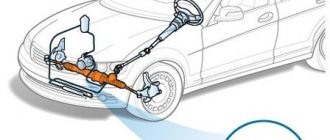A CVT (or CVT) is not as reliable as other types of transmissions. Often the manufacturer gives a guarantee for the CVT - 100,000 km. Sometimes this transmission may not last this long, but there are cases when the resource of the variator could be increased to 300,000 km. What's the secret?
The JF015E variator is installed on LADA cars, and it is also installed on Nissan Juke, Tiida, Qashqai and other Alliance models. How to extend the service life of this and other continuously variable transmissions is told by specialists who are engaged in highly specialized professional repairs of these CVTs.
Pros of a CVT
1. The JF015E variator has become lighter and more compact
(the ground clearance is the same as that of a car with a manual transmission, the transmission is recessed into the perimeter of the subframe, which eliminates damage when driving over large bumps in the road) than previous samples. This was achieved through a new design that uses a V-belt drive, a two-stage planetary gearbox with gears and a torque converter.
2. This variator design is not afraid of frost, slipping and heavy loads
.
3. The gearbox mechanism facilitates the loaded mode
like shifting into reverse gear and back. Now a special electronically controlled clutch is responsible for this. It equalizes the speed of rotation of the shafts, and reverse gear engages smoothly and clearly.
4. The use of a two-stage planetary gearbox made it possible to reduce the resistance when mixing transmission oil by 30%.
(this is especially true in cold weather, when the oil thickens).
5. The design eliminates dangerous moments from the operation of the variator
contact of the belt and cones at the edge or at the axle, where a breakdown could theoretically occur during sliding.
6. The variator cooling system is integrated into one circuit with the engine cooling system. This allows you to effectively maintain the operating temperature
of the transmission
in hot and cold weather.
7. A CVT is more economical than a manual transmission
by 0.2 l/100km (manual transmission - 7.5 l/100km, CVT - 7.3 l/100km).
8. Accelerates easily and smoothly, acceleration occurs without the slightest jerk
, which can be felt, one way or another, on any automatic transmission.
Smooth running is ensured by a torque converter, which is responsible for the clutch function, and a V-belt drive, which additionally smoothes out the loss of traction when switching in the gear section. 9. CVT settings keep engine speed low. It turns out that the engine runs almost silently
.
10. There is no need to change the oil in the variator
, it is designed for the entire period of operation.
Myths about the variator. You don't have to believe in them!
As long as there are CVT transmissions in the world, so many different rumors, prejudices and myths live around them. Let's try to figure out how justified they are using the example of the modern Toyota RAV4 CVT.
But there are many myths, and the first, most common one is “a metal belt is unreliable . So, the service life of a variator with a push belt is no lower than that of traditionally designed automatic transmissions, and even more so of robotic transmissions. There are practically no real failures due to belt wear , and the vast majority of drivers operating cars with continuously variable transmissions do not even know exactly what type of gearbox they have.
Another myth is “the variator does not allow off-road driving . It's hard to say where it came from. Even theoretically, based on the fact that the variator is capable of maintaining any gear ratio and smoothly changing it in any range, it turns out that it is better suited for off-road use than other transmissions. Quickly changing gearbox operating modes from D to R and back is also not a problem. This technique is called swinging, and it is not difficult to perform it on a car with a CVT. The only thing where the Toyota CVT can really give up is very long slipping at high engine speeds. For this purpose, by the way, there is a warning about overheating. But, it should be noted that this is far from the standard mode of operation of the crossover.
We have already talked about the specific working fluid of the variator, and the requirement to fill only a specially designed composition, as you understand, seems completely justified. After all, the “steel on steel” contact requires a special lubricant, which at a certain moment can lose its properties, turning almost into glue, and at other moments - almost into ordinary oil.
Another topic of eternal discussion on the Internet is the unsuitability of the CVT gearbox for sports driving . Firstly, the sport mode shifts all ranges up, allowing you to make more use of high revs. Secondly, the variator, like other modern automatic machines, “learns” perfectly, and when it notices a real athlete behind the wheel, it will respond to him with the most dynamic mode. By the way, the share of torque transmitted to the rear wheels will automatically increase. This will improve handling and stability at high speed, especially when cornering under power.
Once upon a time, CVTs did not like such a simple exercise as overcoming a curb . Modern transmissions do not see any special difficulties in the curb - they “eat up” them in one go. The only rule is to overcome the curb slowly, slowly, pressing on the gas little by little and carefully so that the car does not “shoot out” when the obstacle is behind you.
Well, the last prejudice is trying to instill in us the idea that the variator is completely unrepairable . This is also not true. In fact, if you happen to really burn the belt and pulleys, all of this can be easily replaced. Moreover, the complexity of the work is no higher than during a standard repair of a conventional machine. So don’t believe any myths or garage stories, but, as they say, trust the professionals. However, we are confident that it will not come to that.
Text Evgeny Khapov
On our Zen channel you will always find a lot of interesting things! Subscribe yourself and recommend to your friends!
Disadvantages of a CVT
The operating manual for a car with a CVT indicates:
1. It is recommended to avoid slipping, sudden acceleration and braking
, this is unsafe for the unit and increases wear on the gearbox.
2. For cars with a CVT, towing the car to start the engine is prohibited
.
3. Transporting trailers or towing other vehicles is highly discouraged
, since it significantly increases the load on the transmission, and as a result, increased wear.
What pros and cons of the variator can you name?
Let us remind you that we previously told you how to use a variator (instructions and useful tips).
Keywords: variator | gearbox Lada Vesta | gearbox lada xray | universal article
55
32
Found an error? Select it and press Ctrl+Enter..
- LADA Sport ROSNEFT presented the racing Lada Granta “Touring Light”
- Lada Vesta SW Cross - TO-4 features (60,000 km)
- Results of the Lada Vesta diaries, review after 6 months of operation
- How to protect the gas tank flap by installing an electric lock on a LADA
Experts named the most reliable Japanese crossovers with a CVT
When buying a car, many controversial questions arise that even professionals in the automotive world find it difficult to answer.
Problems often arise when buying a used car equipped with a CVT; the main problem is the question of the reliability of such an SUV. Experts tried to answer these questions and identified the five most reliable crossovers with mileage and a CVT transmission with a price of up to 900,000 rubles. When studying the cars, possible breakdowns of the variator were taken into account, as well as the cost on the secondary market for SUVs from 2010 to 2020, which are relevant in 2020.
The most popular manufacturers of CVT transmissions are Jatco, Aisin and Subaru. Jatco CVTs are often used. Such transmissions are used in models from Renault, Mitsubishi and Suzuki. The Toyota automaker uses CVT gearboxes from Aisin to equip its models. Subaru cars are quite obvious that they use their own gearbox. CVT transmissions from different manufacturers have both positive and negative resources. Apparently, the functionality of the gearbox is determined by the life of the car and transmission.
At the end of the ranking, in fifth place is the Nissan Qashqai crossover with a TR580 CVT, which is installed with a 2-liter gasoline engine. According to research, it became known that the crossover is operated without problems and covers a mileage of 150 to 180 thousand kilometers with systematic diagnostics and timely oil changes.
In 4th position is the Subaru Forester with a CVT transmission from the company TR580. This transmission is equipped with a naturally aspirated engine with a volume of 2 and 2.5 liters; repairs can be done without a mileage of 170 to 200 thousand kilometers.
The bronze medalist was the Nissan X-Trail with a Jatco JF011E gearbox, which works in tandem with a 2 and 2.5 liter gasoline engine. Such a transmission, when used carefully, guarantees a mileage of 180 to 200 thousand kilometers.
The silver rating goes to the Mitsubishi Outlander with a Jatco JF011E CVT transmission; this CVT design is equipped with an additional oil cooling radiator. The variator works with an engine of 2 and 2.4 liters, without repair; when used correctly, such a gearbox allows you to cover from 230 to 250 thousand kilometers, and sometimes it can exceed these readings.
The leading position in the ranking is occupied by the popular Toyota RAV4 with a CVT transmission from Aisin. The transmission works in tandem with a naturally aspirated 2-liter engine. The design of the gearbox has a combined transmission radiator unit and cooling system; thanks to this technology, the car covers distances of up to 300 thousand kilometers.
CVT design features
This type of transmission first appeared at the end of the last century and today, due to its versatility and ease of use, it is popular among buyers. In essence, the design of the variator is extremely simple. The gearbox is based on two sliding pulleys, one of which is connected to the engine by a chain or belt. The pulley halves diverge in different directions, which allows the chain that drives the engine to move along the variator, ensuring smooth power transmission.
A disc pack or torque converter is used as a clutch. The discs used operate in an oil bath, which ensures the durability of this unit and its high-quality cooling during active vehicle operation.
Some modifications of CVTs are equipped with fully automatic control, which allows you to simulate the operation of a standard automatic transmission. In this case, the pulleys will not diverge smoothly, but sharply and stepwise, which allows you to simulate the transition to a higher and lower stage. Such fully automatic CVT transmissions are widely used on Japanese cars]Subaru[/anchor].
RISE TEST
Cars pass the dry country road calmly. We climbed here mainly to test the cars on a steep but dry dirt and sandy climb. The cars did not compete in speed - the engines were too different. The testers' task is extremely simple: stand up several times and evaluate the behavior of the transmissions. On all cars we used the maximum of their capabilities: in the Nissan we selected the Lock mode, in the Mitsubishi we pressed the 4WD button, in the Subaru we pressed X-Mode.
All four-wheel drive vehicles drove up the hill confidently, without whims, which means that there were no losers or winners again. We did not find any signs of excessive stress or overheating of the transmissions.
The front-wheel drive Toyota couldn’t climb this hill - it didn’t have enough “grip”: if we had put it in more toothy tires, it would have overcome the climb, but it still couldn’t compete with all-wheel drive vehicles here.
Probably, by ironing the area for hours, you can make the variators dissatisfied. But it’s difficult to imagine such a need for crossovers in real life. So, it's a draw again.
1. “Outlander” passed the “Overtaking” test with honor.
2. “Subaru” is the winner of the “Overtaking” test: it passed all the tests without the slightest complaints.
3. The largest delay in the operation of the variator after a series of “racing” accelerations and braking is in Nissan, but it turned out to be negligible.
4. The thoughtfulness of the Toyota variator after several mocking accelerations and braking is minimal.
5. “Outlander” passed the “Climb” test without any comments.
6. The capabilities of the Forester engine and transmission are such that steep climbs can be overcome with virtually no acceleration.
7. We did not find any signs of dissatisfaction with the Nissan transmission on a dry country road with steep ascents and descents.
8. The front-wheel drive Toyota didn’t take the climb, but it had every right to do so.
What determines the cost of replacing a variator belt at an auto center?
The procedure can be divided into two phases: primary and secondary examination. In the first case, a visual check is carried out, in the second - after the dismantling of the gearbox is completed. It is quite difficult to see the malfunction because the belt, in accordance with the configuration of the device, is located inside the gearbox housing.
First, the specialist checks the integrity of the gearbox frame, the absence of defects, and leaks. Then he begins disassembling the system.
The main steps: remove the attachment, drain the old technical fluid, disconnect the gearbox housing and the motor block, remove it from under the machine, and place it on the workbench. Then it is necessary to rinse, clean, and dry all the elements, because it is easier to identify defective parts when all the dirt is removed.
Next, the specialist inspects all components of the device and determines those that need to be replaced due to various malfunctions. Then it comes to the V-belt, which is not difficult to replace. It is necessary to turn any drive to the side and remove the element. The new belt is installed in the reverse order.
The cost of replacing a CVT belt will depend on various components. For example, on the make of the car, its age, as well as on the location of the service and prices for services.
How many kilometers until the first maintenance?
As indicated in the vehicle passport, the service life of the Nissan X-Trail CVT before the first major scheduled maintenance is about 100 thousand km. It is recommended to change the transmission oil every six months. In fact, the resource of the Nissan X-Trail CVT is unlimited with proper use and timely maintenance.
Abrasion of the pulleys with proper operation is minimal; the transmission chain should be replaced as needed, on average once a year. Vehicle and automatic transmission diagnostics are carried out every six months. Choose service stations that work with the Nissan X-Trail automatic transmission.
The CVT on the Nissan X-Trail is not the first series of gearboxes with a smooth transmission. Early versions of the variator were tested, studied in various situations and modified. The Nissan X-Trail gearbox is the result of serious improvements and design upgrades that make user errors less critical.











